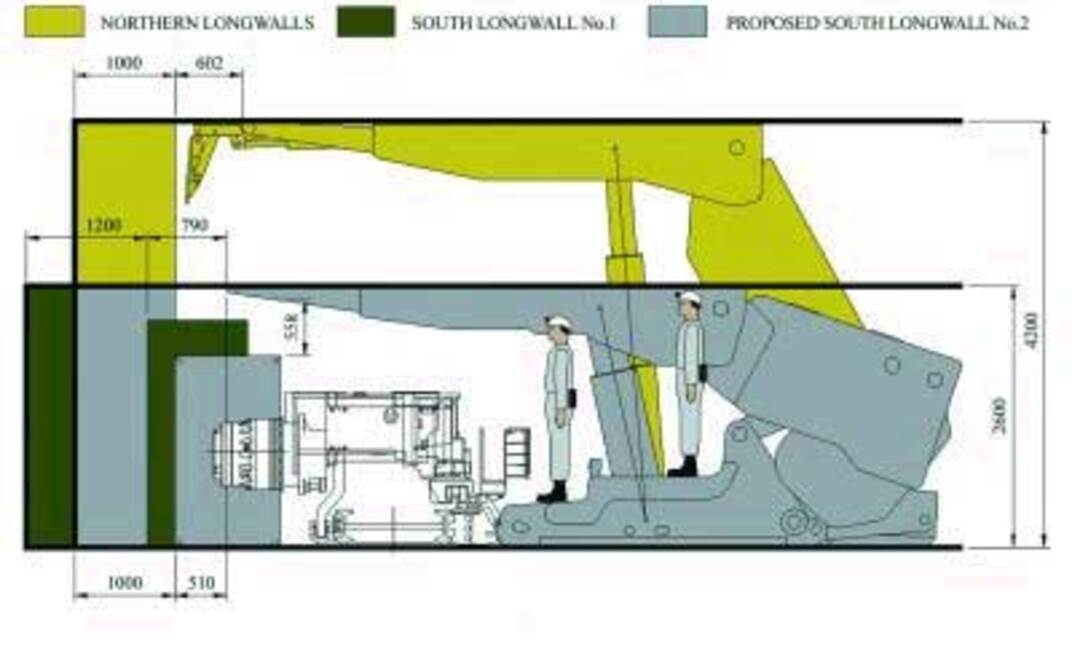Published in Australian Longwall Magazine
A radical re-engineering of the Xstrata Coal Oaky North longwall face has helped overcome operating delays associated with using thick-seam equipment in a thinner seam section.
Oaky North, located in Queensland’s Bowen Basin, is part of the Oaky Creek complex which also includes the Oaky No 1 operation.
Until March last year Oaky North was mining the German Creek seam in the mine’s northern area at a seam thickness above 4m. Mining then moved to the new southern longwall district where the seam thickness drops down to 2.4-2.8m.
To accommodate the lower seam a series of modifications were made before the face was installed, and included lowering of the shearer mainframe, fitting smaller diameter (2.25m diameter) RAC drums and increasing the drum cutting web to 1200mm.
Despite these modifications the mine struggled throughout the first panel with low productivity, equipment delays and strata control issues.
Given the parameters of the installed face equipment, the lowest height the seam could be mined at was 2.7m, predominantly constrained by the shearer drum size. Operating clearance between the shearer and canopies was only a couple of hundred millimetres and collisions were frequent resulting in damage to picks and pick blocks. Slower shearer speeds were required to avoid collisions and to cut the hard roof and floor of the mine.
In addition, the pre-cut tip to face distance was increased by over 60% from 604mm to 990mm. This was associated with the increased cutting web and the need to pin the relay bars out 200mm to establish a front walkway for the high seam supports in the lower seam application. The resulting tip to face distance post-cutting was over 2m, virtually double the average distance used by Australian operations.
Not only was a lot of rock being cut when the seam dropped to 2.4m in thickness, the big tip to face distance radically reduced the effectiveness of the supports in controlling the roof. Falls and slabbing problems were common, translating into other downstream issues with the clearance system such as blockages, conveyor damage, higher wear rates and reduced productivity.
Other than the shearer drum size, mining below 2.7m was also constrained by the spill plate height and subsequent bretby bending radius and shearer mainframe height. Significant delays with bretby cable damage occurred, along with poor access to the shearer, causing something of a maintenance headache.
To solve the problem mine management undertook a major reconfiguration of the equipment with the involvement of original equipment manufacturer DBT.
“Because Oaky North has two sets of equipment we were able to embark on an ambitious project to modify what was on the surface,” said Mark Winchester, Xstrata Coal Queensland’s manager engineering.
Luckily, the mine had access to the spare panline and tailgate drive from Oaky No 1. This allowed the AFC (armoured face conveyor) to be narrowed from 1332mm to 1142mm, reducing the tip to face distance. Narrowing the shearer drum cutting web from 1200mm to 1000mm also reduced the distance.
The Oaky 1 panline is a toe-riding pan which also provides better control and clean-up and has a different spill plate and bretby cable arrangement which has increased walkway space Winchester said. “It also provided better maintenance access to the shearer.”
The mining height was reduced by lowering the equipment. The shearer was both narrowed and lowered. Drum diameter was reduced from 2250mm to 1900mm and the shearer mainframe height by 93mm through angling the down drives outboard.
New DBT EL46 ranging arms with a smaller hub diameter were also fitted to the shearer. The smaller hub diameter allowed the use of a smaller diameter drum whilst maintaining sufficient vane depth and improving the load sharing.
Before the changes the leading drum was cutting over 80% of the average 2.7m seam height.
The change in mining height also had a big impact on the ergonomics of the walkway required to operate the shearer. This was substantially improved with the lower spill trays from the Oaky No.1 panline and relocation of the hydraulic hoses behind the roof support legs.
Operator feedback to the face changes has been very positive, according to longwall superintendent Bernie Lambley.
“Access up and down the face is a lot easier and the ergonomics of a low head-height longwall face are greatly improved.”
When Australia’s Longwalls spoke to Winchester the reconfigured face had been in operation for a few weeks. He said the longwall was cutting much less rock and the tip to face distance was much tighter at 510mm.
He added that the face was running with ‘target push’ whereby the relay bars push out to a designated target rather than the mechanical stop.
“The question is with all these modifications what will the productivity improvement be? With the smaller drums the power per cubic metre is improved. We have achieved more ergonomic walkways to permit faster shearer speeds, and are required to cut and manage significantly less rock.”
Winchester added that with the smaller cutting web the shearer would cut about 1000 tonne per shear.

























